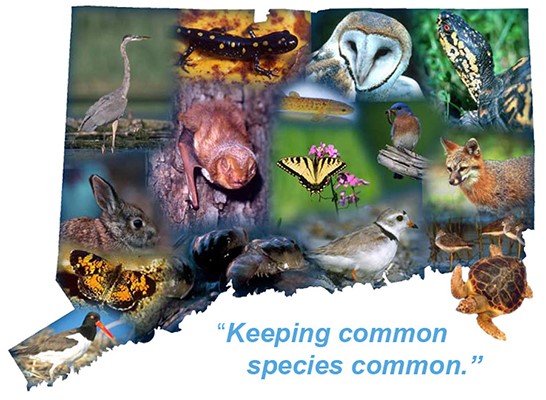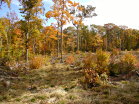Environmental Protection Wildlife Biologist 1 (35 Hour)
Sessions Woods Wildlife Management Area - Habitat Program
Recruitment #191028-9345EE-001
| Location |
Burlington, CT
|
|---|---|
| Date Opened | 11/12/2019 09:30:00 AM |
| Salary | $58,233* - $84,095/year (*New to State employees start at minimum) |
| Job Type | Open to the Public |
| Close Date | 12/6/2019 11:59:00 PM |
Introduction


The State of Connecticut, Department of Energy and Environmental Protection (DEEP) is charged with conserving, improving, and protecting the natural resources and the environment of the State of Connecticut as well as making cheaper, cleaner and more reliable energy available for the people and businesses of the state. The agency is also committed to playing a positive role in rebuilding Connecticut’s economy and creating jobs and to fostering a sustainable and prosperous economic future for the state.
The mission of the Bureau of Natural Resources (BNR) is to conserve and enhance Connecticut fish, wildlife and forest resources and to enhance opportunities for public use and appreciation. BNR carries out this mission through a program of regulation, management, research and public education. BNR is comprised of three Divisions (Fisheries, Forestry and Wildlife) and a central office.
The Wildlife Division currently has an opening for an Environmental Protection Wildlife Biologist 1. This position will be assigned to the Division’s Sessions Woods Wildlife Management Area Habitat Program in Burlington, CT. This program supports the BNR mission by creating, restoring, maintaining and managing a diversity of habitats on state and private lands and developing infrastructure to support wildlife based recreation. This Program administers 109 Wildlife Management Areas (WMA’s), 96 wildlife impoundments, and over 500 miles of boundaries. This program also provides technical expertise to private landowners to plan and implement habitat management.
Habitat work advances management goals in support of state and regional initiatives including the Conservation Strategy for the New England Cottontail (Sylvilagus transitionalis), Young Forest Initiative, the Atlantic Coast Joint Venture and the CT Wildlife Action Plan. State and private land management will support a variety of wildlife, but work will target priority state listed species of greatest conservation need including the New England cottontail, American woodcock and ruffed grouse. This position is accountable for independently performing a full range of tasks in wildlife management, research, and conservation.
This position is full-time, 35 hours per week, normally Monday - Friday, 8:30 am - 4:00 pm. Normally first shift, but hours will vary according to field work, meetings with landowners, contractors and others, and out of office state meeting needs. Incumbents must be willing to work weekends, evenings, early mornings and/or holidays as required.
Applicants must include a resume within the “Resume Tab” of their application.
Questions regarding the required documents should be directed to the hiring agency's human resources office: DEEP.HumanResources@ct.gov or (860) 424-3006.
Selection Plan
This position is competitive. Open to the public.
Applicants invited to interview may be required to submit additional documentation, which supports their qualification(s) for this position.
Please Note: You will be unable to make revisions once you submit your application for this posting to the JobAps system.
The selected candidate must possess a valid driver’s license at time of appointment and maintain it during employment.
Must be willing to travel including out of state and overnight as required
The selected candidate must have adequate physical strength, stamina, physical agility, and must maintain such physical fitness to be able to perform the duties.
Incumbents must be willing to accept assignment or transfer to any area of the State.
PURPOSE OF JOB CLASS (NATURE OF WORK)
EXAMPLES OF DUTIES
Plans and estimates the amount and kind of labor needed on wildlife projects; determines the type and size of equipment to be used on wildlife projects; selects the amount and kind of material required for maintenance of wildlife projects; keeps progress reports and records; prepares reports at completion of wildlife projects; collects data on and makes estimates of wildlife populations to determine changes; investigates the desirability of areas for acquisition including the amounts and kinds of wildlife cover; determines the variation of undergrowth and ground cover in order to evaluate wildlife use; draws up boundary and contour maps; prepares base maps from aerial photographs and field work; locates areas suitable for development as particular wildlife habitat; performs laboratory analysis of various samples; attends and may speak to interested groups; surveys and charts land as to types of vegetation and wildlife; provides technical assistance to landowners; computerizes and analyzes data and generates information for programs to determine health and productivity of wildlife populations; develops informational brochures on wildlife species for public distribution; attends conferences and seminars on wildlife topics; makes suggestions regarding legislation and regulations which will benefit programs and operations of the department; performs related duties as required.
Coordinates with Habitat program staff, other state and federal agencies (e.g. Natural Resources Conservation Service, US Fish and Wildlife Service, Army Corps of Engineers), academic institutions and private landowners to assess, plan, budget, secure permits, and implement habitat management on state and private lands in a wide variety of habitats using a diverse array of techniques (e.g. timber harvests, prescribed burns, mowing and mulching, plantings, invasive species control, integrated marsh management, water level control, and disking). Independently manages projects that support a diversity of wildlife while targeting priority species of greatest conservation need including the New England cottontail, American woodcock and ruffed grouse, in order to advance various grants and initiatives (e.g. Conservation Strategy for the New England Cottontail (Sylvilagus transitionalis), Young Forest Initiative and the CT Wildlife Action Plan).
Collect field data, interpret existing natural resource data, create, use and analyze Arc GIS spatial data and analyze wildlife technical literature in order to develop comprehensive and site specific management plans. Prepare detailed reports, scope of services, grant proposals, and create and maintain databases. Submit requests for state listed species reviews, and secure state and federal permits. Assess and determine infrastructure needs (e.g. service roads, parking lots, gates, boardwalks, and viewing blinds) necessary to support wildlife based recreation and prepare project proposals including contract specifications to carry out repair work and/or development of new infrastructure. Use global positioning devices to develop project boundaries and upload field data to computer to create maps. Read and interpret boundary maps including A-2 survey maps, relocate and mark new boundaries. Prepare technical reports, articles for publication, web content, create and give presentations, organize and participates in workshops, respond to media inquiries. works independently, while closely coordinating with the Habitat Program Supervisor and program staff, state and federal agency staff (including DEEP, Natural Resources Conservation Service (NRCS), US Fish and Wildlife Service (USFWS), Army Corps of Engineers (ACOE)), academic institutions and private landowners to assess, plan, budget and implement habitat management on state and private lands in a wide variety of habitats including; forests, inland and coastal wetlands, grasslands, reverting fields, shrublands and various critical habitats. Management practices include forest harvests, prescribed burning, mowing and mulching with specialized machinery, plantings, invasive control, integrated marsh management, water level control structures and disking.
This specific position will also:
Conduct field work to assess wildlife habitat/wildlife use and areas for potential land acquisition, collect data, interpret existing natural resource data, create, use and analyze GIS maps and spatial data, and analyze wildlife literature in order to develop comprehensive or site specific management/project plans to increase high priority wildlife species populations and/or enhance priority habitat types.
Prepare detailed reports, grant proposals, create and maintain databases, conduct evaluations and report on the success of implemented projects and the effectiveness of various practices.
Assess and determine infrastructure needs including service roads, parking lots, gates, boardwalks, viewing blinds and other improvements necessary to support wildlife based recreation and prepare project proposals including contract specifications to carry out needed repair work and/or development of new infrastructure.
Use GPS to develop project boundaries/upload data/create maps, read and interpret boundary maps including A-2 survey maps, relocate and mark new boundaries.
Provide a wide range of expert technical assistance and outreach to private landowners, municipalities, conservation groups, sportsmen’s clubs, state and federal agencies on wildlife habitat management and priority species.
Work closely with the NRCS to assess habitat, prepare wildlife plans and implement and oversee projects under a range of programs including the Environmental Quality Incentive Program (EQIP), Working Lands for Wildlife (WLFW), and the Regional Conservation Partners Program for Young Forest.
Serve as the Wildlife Division’s representative to the NRCS State Technical Wildlife Subcommittee, the Northeast Habitat Technical Committee, the New England Cottontail Land Management Team and other working groups and committees as needed.
Prepare technical reports and articles, informational bulletins, website content, create and give presentations, organize and participate in workshops, write articles for publications and respond to media inquiries.
Provide input and develop policy, legislation and/or regulations which will benefit the Department.
KNOWLEDGE, SKILL AND ABILITY
MINIMUM QUALIFICATIONS - GENERAL EXPERIENCE
Wildlife management is defined as work requiring a knowledge of scientific fields such as wildlife, biology, zoology, wildlife population dynamics, wildlife ecology, plant ecology, vertebrate zoology, ornithology, mammalogy, animal and plant taxonomy.
MINIMUM QUALIFICATIONS - SUBSTITUTIONS ALLOWED
2. A Master's degree in wildlife management as defined may be substituted for one (1) additional year of the General Experience.
PREFERRED QUALIFICATIONS
Demonstrated experience with the implementation of a variety of habitat management practices such as timber harvesting, prescribed burns, mowing and mulching, plantings, invasive species control, integrated marsh management, water level control and disking, based on habitat assessment, interpretation of environmental data, planning, budgeting and securing of permits.
Experience with preparation of and implementation of comprehensive and site specific habitat management plans.
Strong computer skills including Microsoft Office Suite (Power point, Excel), geospatial informational systems (ARcGis10.6) and data base programs such as Access.
Knowledge and experience with evaluating WMA infrastructure needs and the preparation of project plans/contract specifications to address those needs.
Demonstrated experience providing technical assistance and outreach to private landowners, municipal, state and federal entities on habitat management and targeted species.
Excellent written and oral communication skills.
Excellent interpersonal skills.
Excellent organizational and critical analysis skills, ability to prioritize multiple tasks.
SPECIAL REQUIREMENTS
2. Incumbents in this class may be required to possess and retain a valid Motor Vehicle Operator’s license.
3. Incumbents in this class must be willing to accept assignment or transfer to any area of the State.
PHYSICAL REQUIREMENTS
2. A physical examination will be required.
WORKING CONDITIONS
Conclusion
AN AFFIRMATIVE ACTION/EQUAL OPPORTUNITY EMPLOYER
The State of Connecticut is an equal opportunity/affirmative action employer and strongly encourages the applications of women, minorities, and persons with disabilities.




